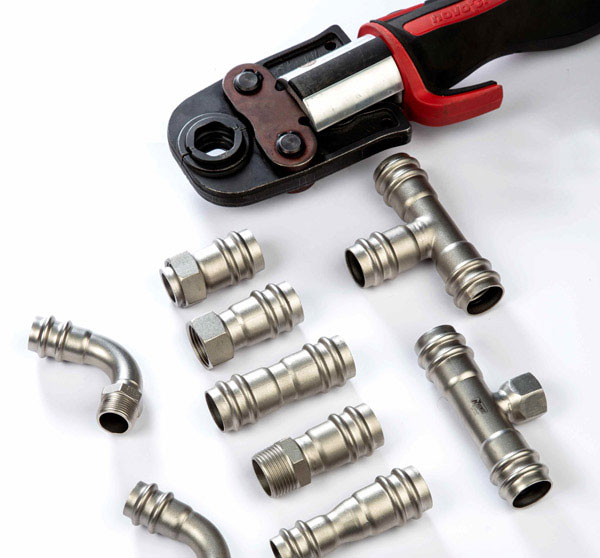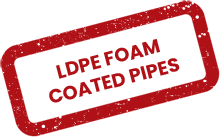- contact@rhinoxusa.com
Rhinox Stainless Steel Pipe is designed for water, compressed air, vacuum, inert gas, and chemical transfer applications. Rhinox Stainless Steel Pipe offers the advantages of being strong and resistant to corrosion. Ideal for caustic washdown and high purity environments. The stainless steel construction makes Transair Stainless Steel Pipe ideal for water and chemical transfer applications that normally would damage aluminum piping. Transair stainless steel drops (3/4",22mm) are made from 316L stainless steel, which is compatible to be in permanent food contact per FDA CFR21 requirements for food contact applications.
Rhinox Stainless Steel Pipe is supplied “ready for use”. No particular preparation (cutting, deburring, chamfering, etc.) is required. Thanks to the rigidity of Rhinox Stainless Steel Pipe, temperature-related expansion / contraction phenomena are reduced to a minimum. The Rhinox network retains its straightness, and hence its performance, over time (reduction of pressure drop caused by surface friction). Rhinox Stainless Steel Pipe is calibrated and fits perfectly onto all Rhinox components. Each connection is automatically secured and sealing is, thus, optimized.

| Nominal Size | Outside Diameter (mm) | Wall Thickness | Dry Weight kg/m | Wet Weight kg/m | Volume I/m | Tube Length mm | 6m Tube Mass kg |
| DN15 | 15 | 1.0 | 0.351 | 0.484 | 0.133 | 6000 | 2.11 |
| DN20 | 22 | 1.2 | 0.625 | 0.928 | 0.302 | 6000 | 3.75 |
| DN25 | 28 | 1.2 | 0.805 | 1.321 | 0.515 | 6000 | 4.83 |
| DN32 | 35 | 1.5 | 1.258 | 2.062 | 0.804 | 6000 | 7.55 |
| DN40 | 42 | 1.5 | 1.521 | 2.718 | 1.195 | 6000 | 9.13 |
| DN50 | 54 | 1.5 | 1.972 | 4.015 | 2.043 | 6000 | 11.83 |
| DN65 | 76.1 | 2.0 | 3.711 | 7.794 | 4.083 | 6000 | 22.27 |
| DN100 | 108 | 2.0 | 5.308 | 13.81 | 8.495 | 6000 | 31.85 |






| Material | C | Si | Mn | P | S | Ni | Cr. | Mo | Ti |
| EN 1.4404 | 0.035 | 1.00 | 2.00 | 0.045 | 0.030 | 10-12 | 16-18 | 2.0-3.0 | - |
| EN 1.4571 | 0.080 | 0.75 | 2.00 | 0.045 | 0.030 | 10-12 | 16-18 | 2.0-3.0 | 0.5-2.5 |
Grade 316L stainless is an austenitic stainless steel alloy with a high chromium and nickel content. Like many steel alloys, it has a continuous use temperature several times higher than most food making processes will ever require (more than 800°C, or 1472°F).
316L alloy is an ideal food grade steel material that has a high resistance to acids, alkalis, and chlorides (such as salt). Other austenitic stainless steels, such as grade 304 SS, can experience severe pitting corrosion when exposed to salt, which is often present in food products. 316Lmakes for great food grade stainless steel for nearly any food application.
316 grade is the second-most common form of stainless steel. It has almost the same physical and mechanical properties as 304 stainless steel, and contains a similar material make-up, 16 and 24 percent chromium and up to 35 percent nickel. The key difference is that 316 stainless steel incorporates about 2 to 3 percent molybdenum. The addition increases corrosion resistance, particularly against chlorides and other industrial solvents.
The differences between a 316L and a 316 straight grade are two-fold both in chemistry and mechanical properties. The L grade has a lower maximum carbon limit and the straight grade has increased mechanical properties. The “L” actually stands for “low carbon” content. If material is certified as straight grade, the carbon content would have to be at a level of 0.030% maximum in order to be dual certified as 316L/316 grade. If the material is certified as 316L that implies the carbon is at a maximum level of 0.030%.
316L stainless steel is commonly used in many industrial applications involving processing chemicals, as well as highsaline environments such as coastal regions and outdoor areas where de-icing salts are common. Due to its non-reactive qualities, 316Lstainless steel is also used in the manufacture of medical surgical instruments.